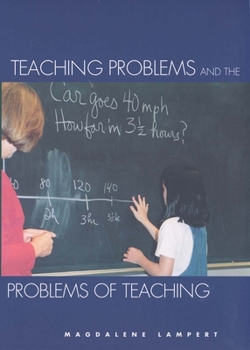Teaching Problems and the Problems of Teaching
Select Format
Select Condition 
Book Overview
In this fascinating book, an experienced classroom teacher takes us into her fifth-grade math class through the course of a year and shows how classroom dynamics--the complex relationship of teacher, student, and content--are critical in improving student performance. Magdalene Lampert offers an original model of teaching practice that casts new light on the ways teachers can successfully deal with teaching problems.
"Although the setting is...
Format:Paperback
Language:English
ISBN:0300099479
ISBN13:9780300099478
Release Date:March 2003
Publisher:Yale University Press
Length:512 Pages
Weight:1.98 lbs.
Dimensions:1.1" x 7.0" x 10.0"
Customer Reviews
2 ratings
Not a Casual Read - But Very Helpful as a Resource
Published by Thriftbooks.com User , 15 years ago
Teaching Problems and the Problems of Teaching This book, by Magdalene Lampert, is one of my textbooks from my teaching certification program at the University of Michigan (MA, Educational Studies, 2006). I had always wanted to go back and re-read it, more carefully, not subject to the pressures of a course syllabus. The book is primarily a set of reflections on teaching math to a classroom of 5th graders. It covers the year, from September to June. Lampert uses transcripts of actual recordings made while she taught, to drive the content of the book. She covers such things as how to establish a classroom culture, preparing for lessons, working with students independently, leading whole-class discussions, teaching to cover the curriculum, etc. There is simply no way to read a book like this casually. There is too much in it, that needs to be filed away for easy retrieval. The best use of this type of teaching instructional book is to refer to it constantly in your own group of upper-elementary kids. This type of teaching resource, however, is not my favorite. The format, where the teachers narrates his or her own moves and behaviors in a live classroom, always struck me as rather self-absorbed. Ms. Lampert is indeed an excellent teacher, that can share much to new teachers. But the "I, me, mine" emphasis throughout becomes a distraction rather than a help. But she will focus on one specific problem, and address her handling of it, in several chapters, covering various teaching situations and concepts. She builds her approach on a triangular model, where the teacher, the students, and the content are at the end-points, and the area in the center is the teacher's "practice", that area where the teacher must manage infinite different scenarios of personality, curriculum, social situations, learning needs, etc. As I read through the book, I found myself formulating my own model, a four-square grid like Covey's Priority quadrants - where the quadrants are based on: Student can/can't do the work; and student does/doesn't "get it". Your goal will be to move the kids up to the quadrant where they both can do the work, and "get it." (I was a math student that could do the work, but never got it until I was an undergrad in calculus). I felt that Lampert quite overdoes the interactions with a student named "Saundra", where she makes a sort-of project out of not letting the class leave for recess until Saundra sees where she made a mistake in a fractions word problem, and will admit it publicly while saving face. There are a lot of layers of concern here, for the teacher, and Lampert handles it well. But I found myself thinking "Let the kids go to recess - Saundra will get it eventually - let it go!" In the modern push for educational reform, we have ample research-based models to guide the teacher. We know more about human behavior and development than ever before. But somewhere lost in the mix is the idea of just letting kids be kids, letting them
Best Book about Teaching I've Ever Read
Published by Thriftbooks.com User , 17 years ago
This book attempts to lay out the terrain of teaching in all its complexity. The author collected a huge amount of triangulated data about a year of her elementary math teaching, and analyzed it in several dimensions, including establishing a classroom culture in the first week of school, teaching in small groups, large groups, choosing curriculum, and establishing students' identities as persons who do mathematics. The author cogently argues that understanding teaching requires a high degree of sophistication, and that the drop-in observer, armed with checklists of best teaching practices, can almost never understand what is going on in the classroom. One of the goals of this book is to provide teachers with a start on acquiring the intellectual tools and language to be able to talk about teaching so others can comprehend it. Although the topic is ostensibly fifth grade mathematics teaching, the issues it addresses run across disciplines and grade levels. I use it with my secondary science methods students, as it provides a framework for understanding teaching.





